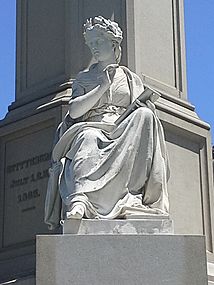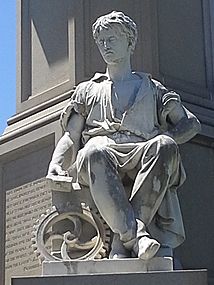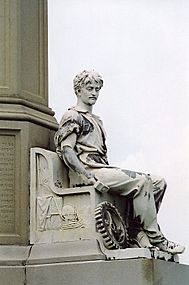Soldiers' National Monument facts for kids
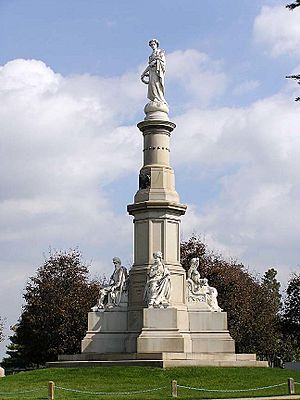 |
|
| Coordinates | 39°49.186′N 77°13.873′W / 39.819767°N 77.231217°W |
|---|---|
| Location | Gettysburg National Cemetery |
| Designer | Randolph Rogers George Keller (architect) |
| Beginning date | July 4, 1865 |
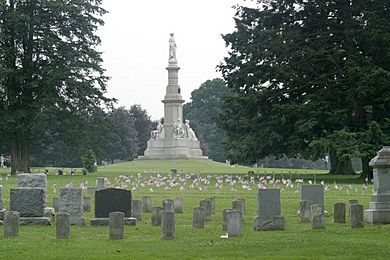
The Soldiers' National Monument is a special memorial. It stands in the middle of the Gettysburg National Cemetery. This monument honors the brave soldiers who fought in the Battle of Gettysburg. It also tells a story about "peace and plenty under freedom." This peace comes after a heroic struggle.
The monument has a tall central part. It has four supports, called buttresses. On top of this central part is a large statue. This statue represents Liberty. Around the base of the statue are eighteen bronze stars. These stars stand for the eighteen Union states. Soldiers from these states are buried in the cemetery.
At each corner near the base of the monument, there is another statue. These four statues represent important ideas: War, History, Peace, and Plenty.
- War is shown as an American soldier. He is telling the story of the battle to History.
- History is shown writing down the brave deeds of the battle. She also records the names of the soldiers who died.
- Peace is shown as an American mechanic. He has his tools with him. This shows how peace helps build things.
- Plenty is a female figure. She holds a bundle of wheat and fruits. This shows that peace brings good things and lots of food. It is like the reward for the soldiers' bravery.
History of the Monument
The idea for the monument started in 1865. The state of Massachusetts agreed to help pay for it. On March 14, 1865, they approved money for the Gettysburg Soldiers' National Monument Association.
In May 1865, David Wills invited groups of veterans. They came for a special ceremony on July 4. This was when the monument's first stone, called the cornerstone, was laid. Pictures of the planned design were available soon after.
The main parts of the monument were built in Westerly, Rhode Island. The statue of Liberty was sculpted in Rome, Italy. This statue arrived in October 1868.
The monument was officially dedicated on July 1, 1869. However, the statues of Plenty and Peace were not yet in place. Many important people attended the ceremony. Reverend Henry Ward Beecher gave a prayer. General George G. Meade gave a speech. Senator Oliver P. Morton also gave a speech. A poet named Bayard Taylor read a poem.
The Plenty statue was added later, on August 26, 1869. A book about the cornerstone and dedication ceremonies was published in 1874.
Many people think the monument is where the famous Gettysburg Address was given. But this is not true. The actual spot where Abraham Lincoln gave his speech is about 40 yards east of the monument. When he spoke, he was facing west. He was looking towards a flagpole that stood where the monument is now.
Photo Gallery


